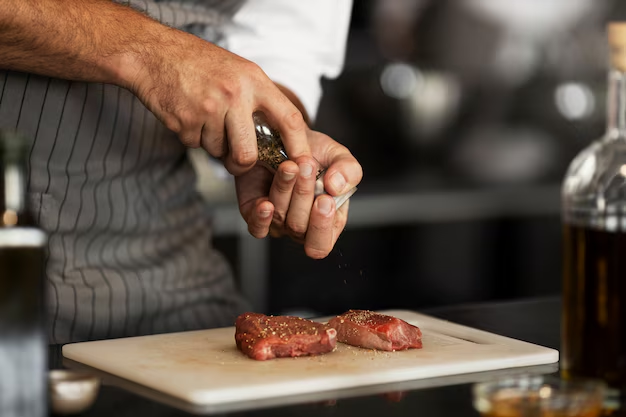Is It Safe to Store Warm Meat in the Refrigerator? Here's What You Need to Know
When it comes to food safety, questions often arise about the best practices for storing leftovers, especially when it involves meat. One of the most common inquiries is whether it's safe to put warm meat directly into the refrigerator. Let's delve into this topic, exploring the factors that influence safety and best practices for storing meat.
🥩 Why Temperature Matters: Understanding the Basics
Temperature plays a crucial role in food safety. The key is to prevent meat from lingering too long in the "danger zone," which is typically between 40°F (4°C) and 140°F (60°C). In this range, bacteria grow rapidly, increasing the risk of foodborne illnesses. Therefore, proper cooling and storage methods are essential.
The Danger Zone: What It Means for Meat
- Bacteria Growth: Within the danger zone, bacteria such as Salmonella and E. coli can double in number within just 20 minutes.
- Safety Concerns: Increased bacteria can lead to food contamination, causing potential health issues.
🕒 Timing and Methods for Cooling Meat
One of the most effective ways to avoid the danger zone is cooling meat quickly. Here are some recommended methods:
Best Practices for Rapid Cooling
- Portioning: Divide large cuts into smaller portions to speed up the cooling process.
- Shallow Containers: Use shallow containers to increase surface exposure to cooler air.
- Ice Bath: Place the container in an ice bath for quick cooling before refrigerating.
🌀 Can You Refrigerate Warm Meat? Debunking Common Myths
Contrary to some beliefs, placing warm meat directly in the fridge isn't always harmful. However, context matters:
Refrigeration Myths and Realities
Myth: Warm meat will spoil if placed in the refrigerator.
- Reality: While the fridge may have to work harder initially, it will prevent bacteria growth more effectively than leaving meat out.
Myth: Refrigerating warm meat affects its flavor.
- Reality: Proper cooling methods will help retain optimal taste and texture.
📦 Proper Storage Techniques for Meat
Understanding how to store meat effectively is vital for preserving its safety and quality.
Key Storage Guidelines
- Sealed Containers: Use airtight containers or wrap tightly in plastic wrap or foil to prevent moisture loss and contamination.
- Labeling: Note the date of storage to ensure freshness and facilitate proper rotation of older items.
🔄 The Role of Refrigerators and Settings
Your refrigerator is designed to keep your foods cool, but its efficiency can be influenced by a few key factors, particularly when dealing with warm items.
Refrigerator Efficiency Tips
- Avoid Overloading: Ensure air can circulate around food for even cooling.
- Temperature Checks: Regularly verify that your fridge stays at or below 40°F (4°C).
📋 Summary of Practical Tips
Here's a concise list of best practices for safely cooling and storing warm meat:
- 🕒 Cool Rapidly: Use ice baths or shallow containers for quick cooling.
- 🥶 Fridge Settings: Ensure refrigerator stays below 40°F for optimal safety.
- 📦 Smart Storage: Seal meat well and label for freshness tracking.
- 🔄 Efficient System: Avoid overloading your refrigerator to maintain airflow.
👨🍳 Additional Considerations and Tips
Real-World Scenarios: Adjusting Techniques Based on Situation
- Large Gatherings: Investing in a secondary cooler or fridge can be beneficial for parties or family events where multiple dishes need quick cooling.
- Energy Efficiency: Consider energy-efficient models that can handle demand without straining your home’s power consumption.
🌟 Pro Tips for Home Chefs
- Meat Preparation: Precook large quantities and cool before storing to streamline meal prep.
- Mindful Consumption: Plan meals around stored meat to reduce waste and maximize freshness.
🍽 Maximizing Leftover Potential
Once you've safely stored your meat, creativity can help get the most out of your leftovers.
Delicious and Safe Leftover Ideas
- Savory Soups: Add cooled meats to broths and vegetables for a hearty soup.
- Homemade Sandwiches: Combine with fresh ingredients for flavorful sandwiches.
- Casseroles and Stir-Fries: Reinvent cooked meats in baked dishes or quick stovetop meals.
🌈 Conclusion: Achieving Safe and Efficient Practices
Navigating the do's and don'ts of meat storage can seem daunting, but by understanding the role of temperature and following simple guidelines, anyone can safely store meat. By prioritizing rapid cooling, efficient refrigeration, and mindful consumption, you ensure your meals are both safe and delicious. Whether you're a novice cook or an experienced chef, these best practices are your allies in the kitchen.
Remember, when it comes to food safety, a proactive approach goes hand-in-hand with culinary creativity. So next time you're left pondering whether to put that warm roast in the fridge, now you know how to keep it safe and snug. Here's to good food and good health! 🥂
